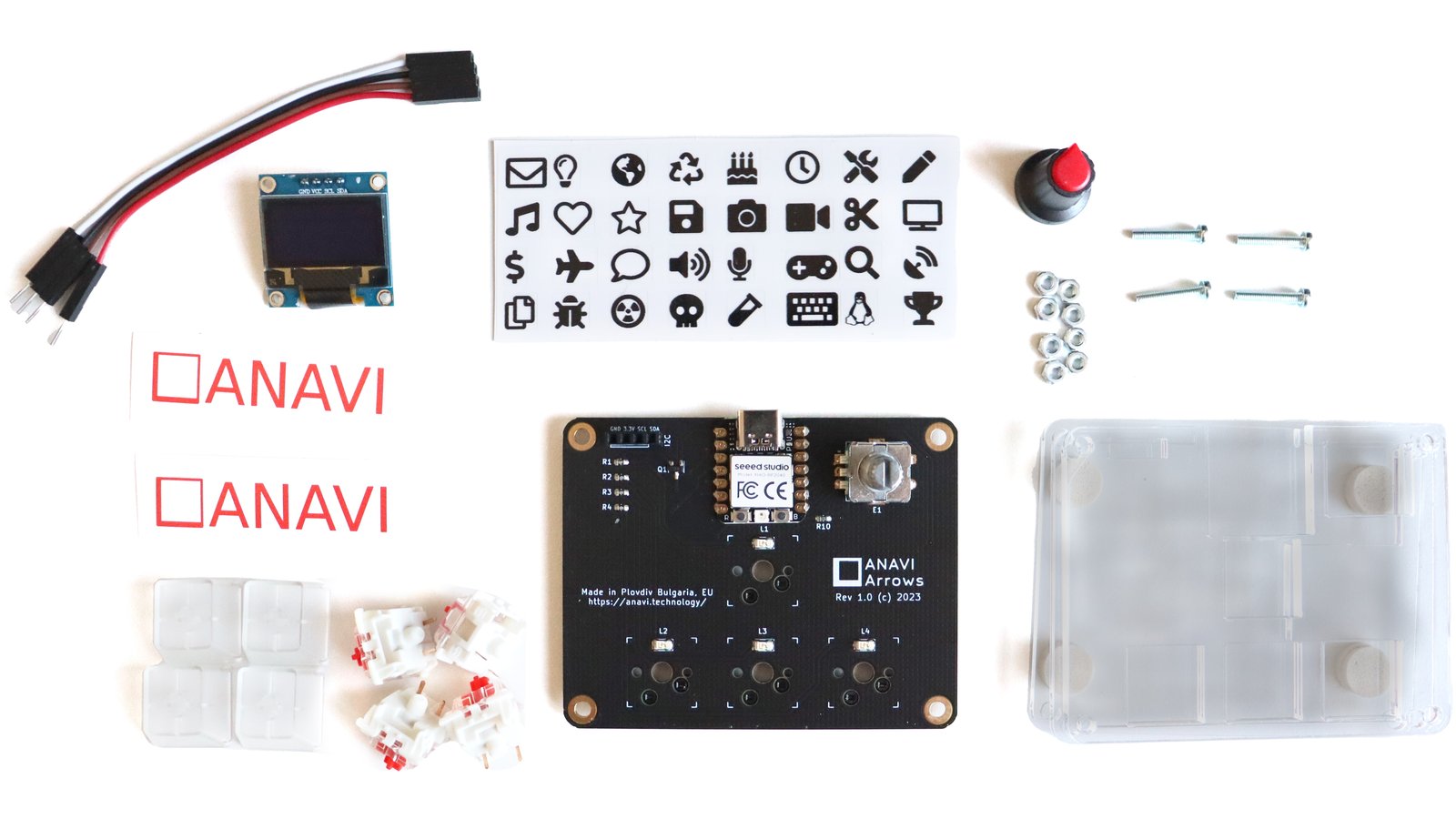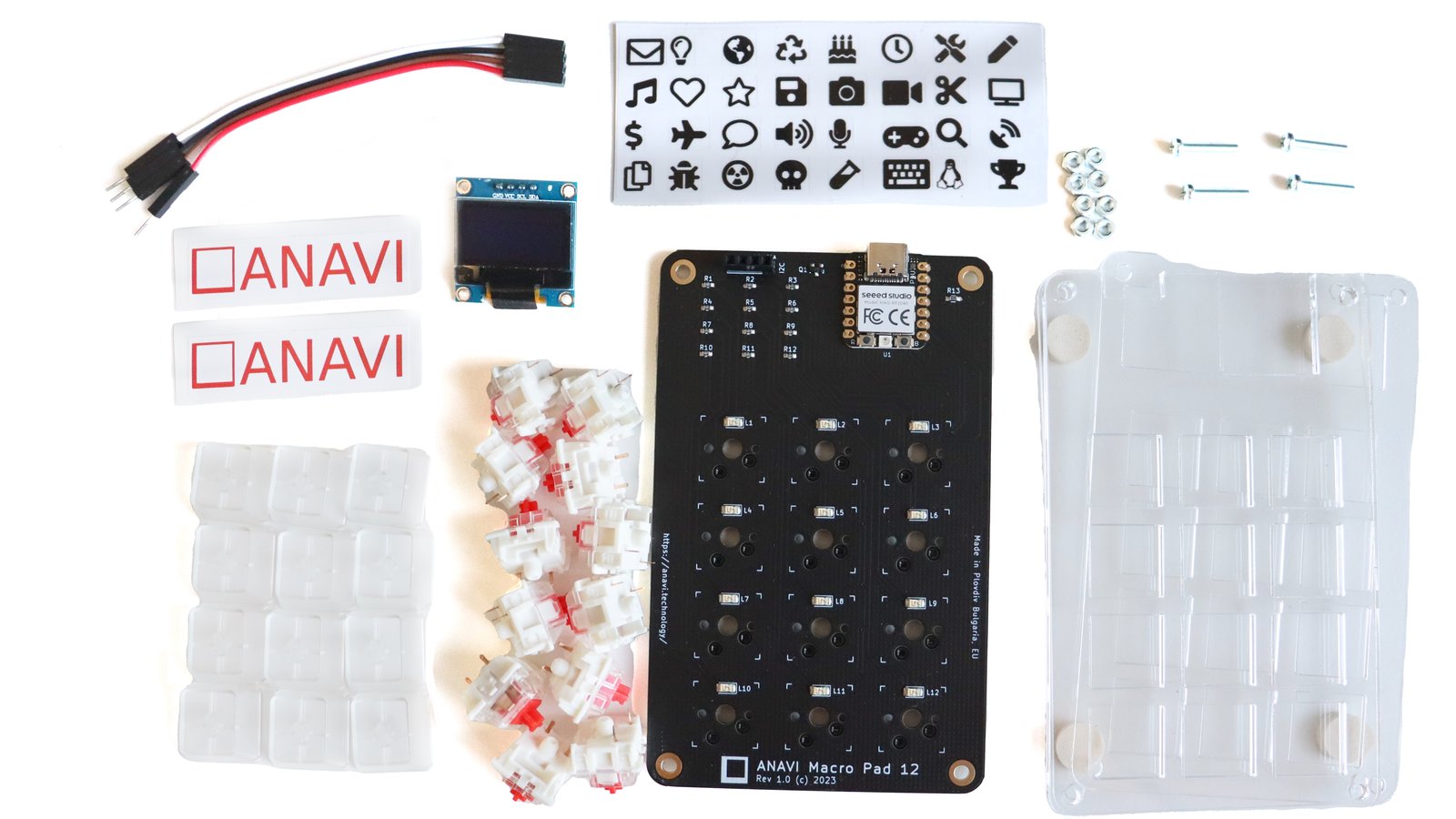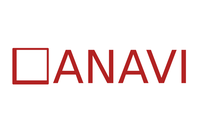ANAVI Technology
Home Automation
KiCad
ANAVI Technology
Home Automation
KiCad
Unleash your typing potential with our new small, fully programmable, open source mechanical keyboards with hot-swappable sockets: ANAVI Macro Pad 12 and ANAVI Arrows. Both macro pads are powered by the Raspberry Pi RP2040 microcontroller at the heart of the Seeed XIAO RP2040, which provides support for USB Type-C. Each kit includes a mini yellow-blue OLED display for the dedicated I2C connector. Out of the box, the keyboards are powered by the open source KMK firmware, written in CircuitPython.
Each of these two small mechanical keyboards can fit a range of versatile use cases: video or audio editing, entertainment broadcasting, gaming, programming, etc. Boost your productivity with the precise control and helpful lighting effects they provide! Getting started is easy..no soldering required! Just connect the device to your Windows, MacOS, or GNU/Linux computer with a USB Type-C cable and you’re ready to go.
ANAVI Macro Pad 12 offers twelve fully programmable, hot-swappable, Gateron red mechanical switches with translucent keycaps. The black, gold-plated PCB features yellow back-lighting under each key, RGB LED on front and six WS2812B LEDs for under lighting effects. The hot-swappable sockets allow you to change the mechanical switches easily, with no soldering required. The device has a I²C slot for adding peripherals, such as a mini OLED display, included in the kit.
ANAVI Arrows is a small, fully programmable, mechanical keyboard. The device offers a single rotary encoder with a clickable switch, a RGB LED, and four Gateron red, linear, non-clicky mechanical switches with transparent keycaps and yellow LED back-lighting. You can easily turn the rotary encoder left or right, and you also can click it, which is all fully programmable! ANAVI Arrows uses a black, gold-plated PCB and features yellow back-lighting under each key. It also has four WS2812B LEDs on the underside for under-lighting effects. An I²C slot allows for adding peripherals, such as our included mini OLED display.
Upgrade your typing experience to a new level of sophistication and functionality with a mini OLED display - the ultimate companion for the discerning typist or passionate gamer. From displaying system stats, notifications, or custom animations, the possibilities are limitless.
Each kit of ANAVI Macro Pad 12 and ANAVI Arrows contains a mini yellow-blue I2C OLED display. I2C, short for Inter-Integrated Circuit, is a widely used serial communication protocol. A dedicated connector on the printed circuit board of each keyboard lets you plug in the included mini OLED display. You can add other I2C devices, for example a gesture sensor, to the same connector. The open source firmware KMK has support for OLED display.
Hot-swap sockets for mechanical keyboards utilize specialized connectors that allow you to easily and conveniently swap out or replace switches without the need for soldering. The printed circuit boards of both ANAVI Macro Pad 12 and ANAVI Arrows feature hot-swap sockets.
You can tailor your typing experience to your preferences. Whether you prefer linear, tactile, or clicky switches, you can easily swap key switches in and out to find the perfect match for your typing style. Furthermore, hot-swap sockets allow effortless replacement in case of a faulty switch or when trying out new switch variants.
Kits with ANAVI Macro Pad 12 and ANAVI Arrows feature Gateron red mechanical switches and translucent keycaps. However, you can easily experiment and use any Cherry MX compatible switch with the hot-swap sockets.
You can easily get started with ANAVI Macro Pad 12 and ANAVI Arrows, thanks to the compatibility with popular open source projects. Just connect the keyboard to your Linux, Windows, or macOS computer, and configure your keyswitch macro or shortcut settings through the open source KMK firmware available under GPLv3 and written in CircuitPython. ANAVI Macro pads are officially supported by KMK, and you can find our ANAVI firmware in KMK’s GitHub repository.
CircuitPython is a software implementation written in C of a programming language largely compatible with Python 3 and optimized to run on constrained embedded devices such as microcontrollers. It has been derived from MicroPython. KMK is a keyboard focused layer that sits on top of CircuitPython, which makes programming custom keyboards easy.
Both ANAVI Macro Pad 12 and ANAVI Arrows are open hardware products designed with free and open source software. Their default open source firmware is KMK ("Clackety Keyboards Powered by Python"). Source code and schematics are available on GitHub. A comprehensive user’s manual will be provided.
| ANAVI Macro Pad 12 | ANAVI Arrows | ANAVI Macro Pad 10 | ANAVI Macro Pad 8 | ANAVI Knobs 3 | ANAVI Macro Pad 2 | ANAVI Knob 1 | |
|---|---|---|---|---|---|---|---|
| Mechanical switches | Yes (12) | Yes (4) | Yes (10) | Yes (8) | No | Yes (2) | No |
| Hot-swappable | Yes | Yes | Yes | No | No | No | No |
| Rotary Encoder | No | Yes (1) | Yes (1) | No | Yes (3) | No | Yes (1) |
| Under-lightning | Yes | Yes | Yes | Yes | No | No | No |
| Backlighting | Yes | Yes | Yes | Yes | No | Yes | No |
| Mini OLED display | Yes | Yes | No | Yes | Yes (Optional) | No | Yes (Optional) |
| Connector Type | USB Type-C | USB Type-C | USB Type-C | MicroUSB | USB Type-C | MicroUSB | USB Type-C |
| MCU | Raspberry Pi RP2040 | Raspberry Pi RP2040 | Raspberry Pi RP2040 | Microchip ATmega32U4 | Raspberry Pi RP2040 | Microchip ATtiny85 | Raspberry Pi RP2040 |
| Open Source Hardware | Yes | Yes | Yes | Yes | Yes | Yes | Yes |
There are literally hundreds of high-quality mechanical keyboards on the market. Using our previous experience from our ANAVI Macro Pad 10, ANAVI Macro Pad 8, ANAVI Knobs 3,ANAVI Macro Pad 2 and ANAVI Knob 1, and new modern technologies, we are proud to be delivering ANAVI Macro Pad 12 and ANAVI Arrows. Both of these mini mechanical keyboards are with 6 distinguishable features: fully programmable, hot-swappable, mini OLED display, Gateron red mechanical switches, USB-C, Raspberry Pi RP2040 microcontroller and open source firmware.
Furthermore, unlike many of the other options on the market, our keyboards are entirely open source, affordable, compact, and highly customizable for a wide range of applications.
All units are made in Plovdiv, Bulgaria and packaged in eco-friendly recyclable cardboard boxes. To ensure consistently high quality, the printed circuit boards (PCBs) of ANAVI Macro Pad 12 and ANAVI Arrows have a black solder mask and a gold surface finish. All kits are using the same key components: Seeed Studio XIAO RP2040, hot-swap sockets, Gateron red switches, translucent keycaps, and mini OLED display. The castellated holes on XIAO RP2040 allow easier assembly with surface-mount technology (SMT). All keyboards are carefully flashed and tested with the open source KMK firmware.
Produced by ANAVI Technology in Plovdiv, Bulgaria.
Sold and shipped by Crowd Supply.

Mini mechanical keyboard with a rotary encoder, 4 Gateron red switches, translucent keycaps, USB-C, RP2040 microcontroller, yellow-blue mini OLED I2C display, backlighting, underlighting, acrylic enclosure, screws and nuts.

Mini mechanical keyboard with 12 Gateron red switches, translucent keycaps, USB-C, RP2040 microcontroller, yellow-blue mini OLED I2C display, backlighting, underlighting, acrylic enclosure, screws and nuts.

· AnaviTechnology · AnaviTechnology · anavi.technology
Open source hardware created and powered by free and open source software